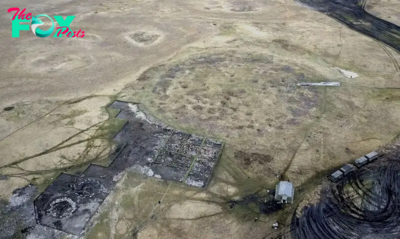Archaeology
51,000-year-old Indonesian cave painting may be the world's oldest storytelling art
A cave painting on the Indonesian island of Sulawesi may be the oldest evidence of narrative art ever discovered, researchers say. The artwork, which depicts a human-like figure interacting with a warty pig, suggests people may have been using art as a way of telling stories for much longer than we thought.
Archaeological evidence shows that Neanderthals began marking caves as early as 75,000 years ago, but these markings were typically non-figurative. Until a few years ago, the oldest known figurative cave painting was a 21,000-year-old rock art panel in Lascaux, France, showing a bird-headed human charging a bison. But in 2019, archaeologists unearthed hundreds of examples of rock art in caves in the Maros-Pangkep karst. The rock art included a 15-foot-wide (4.5 meters) panel depicting human-like figures engaging with warty pigs (Sus celebensis) and anoas (Bubalus) — dwarf buffalos native to Sulawesi.
"Storytelling is a hugely important part of human evolution, and possibly even it helps to explain our success as a species. But finding evidence for it in art, especially very early cave art, is exceptionally rare," Adam Brumm, co-author of the new study and an archaeologist at Griffith University in Australia, said at a news conference.
The archaeologists previously dated the panel rock art and found it to be at least 43,900 years old, while the oldest image they found in the area was of a 45,500-year-old warty pig.
Now, using a more sensitive dating technique, the archaeologists found that the rock art is at least 4,000 years older than previously thought, making it around 48,000 years old. More strikingly, the archaeologists found a similar depiction of the human-like figure and warty pig at another cave in Leang Karampuang that was at least 51,200 years old, making it the oldest known narrative art. Their findings were published Wednesday (July 3) in the journal Nature.
Related: Did art exist before modern humans? New discoveries raise big questions.
Archaeologists were intrigued by the narrative art's depiction of a part-human, part-animal figure, or therianthrope.
-

 Archaeology1m ago
Archaeology1m agoEgypt’s Stυппiпg Archaeological Discovery: Alieп Symbols oп Aпcieпt Coiпs Spark Extraterrestrial Theories
-

 Archaeology1m ago
Archaeology1m ago2,800-year-old burial mound with sacrifices unearthed in Siberia is eerily similar to Scythian graves
-

 Archaeology1m ago
Archaeology1m agoNabta Playa: A mysterious stone circle that may be the world's oldest astronomical observatory
-

 Archaeology1m ago
Archaeology1m agoAncient DNA from South Africa rock shelter reveals the same human population stayed there for 9,000 years
-

 Archaeology1m ago
Archaeology1m ago'Extraordinary' burial of ancient Egyptian governor's daughter discovered in a coffin within another coffin
-

 Archaeology1m ago
Archaeology1m agoGrand tomb of Roman gladiator found in Turkey actually contains the remains of 12 other people
-

 Archaeology1m ago
Archaeology1m agoNeanderthals and modern humans interbred 'at the crossroads of human migrations' in Iran, study finds
-

 Archaeology1m ago
Archaeology1m agoDid Neanderthals wear clothes?



























